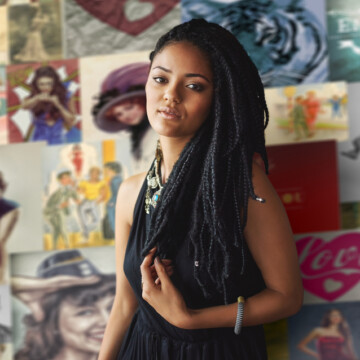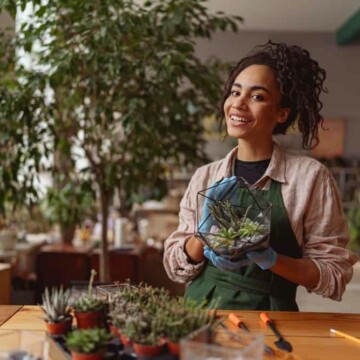
Our hair is much more than a fashion accessory - it offers protection from external elements, regulates our body temperature, and more. But the funny thing is that, although all human hair serves the same basic functions, the number of hairs on our heads is unique to us.
In this article, we’ll tell you how many hairs are on a human head and fill you in on some other interesting facts. It's important to note that this article covers scalp hair and doesn't consider body hairs that aren't on the scalp.
Table of Contents
How Many Hairs Are on a Human Head?

On average, humans have 100,000 hairs on their heads, but this number is not consistent across the board. Your hair density (the number of hairs on your head) depends on many factors. Some of the main ones are race and hair color.
We will look at each of these factors and their effect on your hair’s density.
Hair Density and Race
There are no exact hair density numbers when it comes to race, but here are a few things to know for comparison’s sake:
- Caucasians have more hair strands or scalp hairs than all other races.
- Asians have a much lower hair density than Caucasians.
- African American hair density is somewhere between that of Caucasians and Asians.
Though there are no specific numbers for African hair, it has been proven that black people have fewer terminal hair follicles on their heads.
This lower number of individual hairs among black people is not necessarily a bad thing. The twists and turns in naturally curly hair give the illusion of higher density even though there are fewer individual strands.
Hair Density and Color
The hair color we are born with is another contributor to how many hairs we will have throughout our lives. Blondes have the most individual strands of any hair color, at about 150,000 hairs.
Brown hair is the next highest, with an average of about 110,000 strands of hair. People with black hair usually have about 100,000 hairs.
Redheads have the least amount, at 90,000. Of course, these numbers are for healthy people with no medical issues that can cause hair thinning or baldness.
Does Gender Affect Hair Density?

Some may believe that gender affects hair density. However, gender doesn’t seem to affect the number of hairs we have on our heads. It does alter how the hair grows, though.
The hair on a man’s head tends to grow quicker than women’s hair. This is why men need to get it cut more frequently if they prefer to maintain a specific length.
Can You Increase Your Hair Density?
By now, we trust that you have a good idea of the number of hairs on a human head. The next question you may have is whether you can increase your hair density.
Since our hair grows from a finite number of scalp hair follicles, there’s no way to increase our hair density. We can’t do anything to generate more hair follicles, after all.
But what we can do is make sure that we’re consuming a healthy diet - this will ensure that each hair follicle is supplied with the nutrients we need for healthy hair growth.
If you are dealing with severe hair loss, hair transplant surgery can help to increase your hair density, but there is no other way to increase the number of hair follicles on your head.
If you're dealing with hair loss or shedding, we recommend speaking with a medical professional to review your options. In the next section, we'll discuss dealing with shedding and hair loss.
How Much Shedded Hair is Normal?

Whenever we shower or brush our hair, there are always loose strands caught in our shower drain, between our fingers, or in the bristles of our favorite brush or comb.
We may even notice loose hairs on our clothing or bedding quite regularly. This is perfectly normal since the human head loses somewhere between 50 and 100 strands each day.
This hair loss isn’t anything to worry about. Our hair goes through regular growth cycles, just like the rest of our bodies.
There are four stages in a hair’s growth cycle, and we’ll look at them below:
Hair Growth Cycle
- Anagen. The anagen phase is a growing phase, where the hair is actively growing. The phase lasts about 3 years.
- Catagen. The catagen phase is the transition phase. In this phase, the hair’s growth rate slows down a bit, and the hair starts to detach from the follicle. This stage lasts around 2 weeks.
- Telogen. The telogen phase is the resting phase. This is when the hair stops growing but doesn’t fall out yet. The hair may stay in this phase for about 3 months.
- Exogen. The exogen phase is the shedding phase, in which the hair falls out. During this phase, new hair is also beginning to grow within your follicle.
Each of your hairs could be in any of the above stages at a given time. But there are times when this cycle is altered.
Those dealing with hormonal changes, such as pregnancy, childbirth, or menopause, may notice that their hair is staying put or falling out much more rapidly than usual.
Post-partum hair shedding is alarming to many because the hair loss is often very sudden - luckily, this problem rectifies itself without any outside intervention.
Some medical issues or treatments can also alter your hair’s regular shedding until the condition is under control. Even stress and a lack of nutrition can affect your hair’s natural growth cycle.
Staying healthy physically and mentally can keep your hair shedding at its normal rate.
When is Hair Loss a Problem?

Though there are times in our lives when our hairs shed at a faster or slower rate, the issue usually corrects itself. But if your hair is falling out and you see no signs of improvement, you may be dealing with more than a simple hormonal or medical change.
Unfortunately, these types of issues may not be resolved with a quick trip to your doctor. Read on to learn about some conditions that cause hair loss.
Alopecia
An increase in hair shedding can be related to hair loss or alopecia. This means that the hair you’re losing isn’t going to grow back. Though this type of hair loss is common in men and women as we get older, it isn’t always age-related.
Lupus and Other Conditions
Though some medical conditions or treatments can cause hair loss, they are usually not permanent, except in extreme cases - one such severe case is lupus.
This disease can cause lesions on the scalp and patchy hair loss, as can the medication used to treat it. Liver disease, renal failure, inflammatory bowel disease, and folliculitis may also cause hair loss.
So, if you notice that you’re losing more hair than usual and don’t know why it is best to speak with your doctor as soon as possible.
A trained professional can help you find out the cause and discuss possible treatments with you for this issue. They may refer you to a dermatologist who can look deeper into the issue and determine what’s going on.
In some cases, dermatological treatment can restore your hair to its former thickness. Avoid using heat styling tools and harsh chemical treatments until you consult with a medical professional.
Frequently Asked Questions

How Many Hairs Fall Out in a Day?
We naturally lose between 50 and 100 hairs a day. While it is normal to shed slightly more than this, sudden scalp hair loss is often an indication of excessive hair shedding or another underlying condition.
How Many Hairs Are on a Woman's Head?
The average human head holds approximately 100,000 hairs, but that number can vary per race and hair color. For instance, people with blonde hair are said to have an average of 150,000 scalp hairs on their heads. The brown hair average is about 110,000 hairs and the average redhead has around 90,000 hair strands on their scalp.
How Many Hairs Grow on the Human Head a Day?
Hair growth is a lengthy process. There are varied factors that affect hair growth over time, but the primary one is simply waiting for it to happen. The average person will grow about ½ an inch of hair per month or about 6 inches in a year.
How Many Hairs Exist per Square Inch on a Human Head?
According to a study conducted by Dermatologic Surgery, which measured hair density in 50 participants (on average from 800-1,290 hairs per square inch and 124-200 per square cm).
So, there you have it! There are thousands upon thousands of hairs on the human head, though the actual number can vary from person to person. This all depends on your natural hair color and the genetics of the person growing it.
Still, regardless of what your race, ethnicity, and hair color are, be sure to keep your hair as healthy as possible through regular maintenance, so it stays where it belongs.
We hope that this article has answered all of the questions you have about hair density and related issues.




